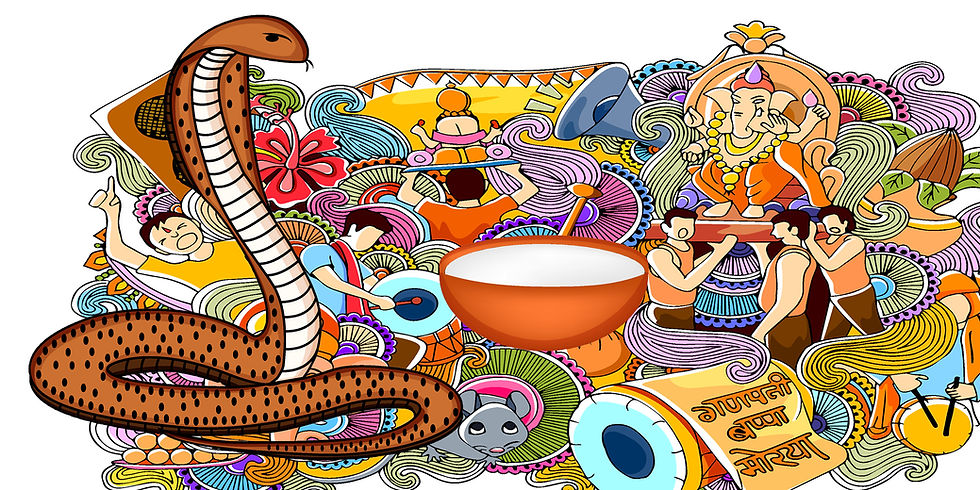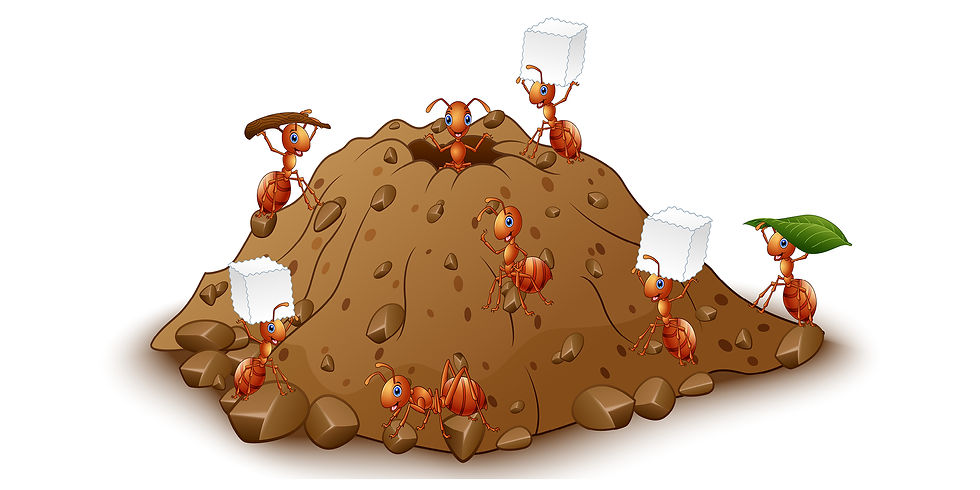Naagara (Nag) Panchami - The thought behind the Action
- Prof. PR Mukund
- Aug 9, 2018
- 4 min read

Background
In the Vedic way of life, every single act from eating to sleeping has a spiritual significance. In this way of life, there are a number of festivals that are celebrated all through the year in which the Spiritual component is given the primary significance. Every festival has something to offer for our spiritual growth. Let’s take a look at Naagara Panchami. This festival is celebrated on the Panchami (5th Day) of the first half of the month ShrAvaNa in the Lunar calendar. There is a reason why we celebrate this festival on this particular tithi of this particular month, which we will look at later in this article. On this day, we see people go near an ant hill for doing puja and finally offer milk as nivedana, supposedly to the snake residing within. Some people even go as far as inviting snake charmers and pour milk on the poor snake. Is this the way Nag Panchami is supposed to be celebrated? What Spiritual significance can there be in pouring milk over the snake, supposedly living in the ant hill?
Deterioration of Vedic Spiritual Knowledge
In the recent times the knowledge behind why we do what we do has been lost and hence, many of these things have turned into mere rituals. When we start doing something mechanically without understanding the Spiritual knowledge behind it, there is no benefit from it and then it is a matter of time for these acts to be termed as superstition and disregarded in society. In this short article, let us examine the thought behind the action in the observance of Naagara Panchami.

Decoding “Naagara (Nag) Panchami”
Symbolism and Numerology play an important role in understanding the Spiritual essence of any Vedic festival. Let us take the word “Nagara”. The beauty of Sanskrit words are in it’s etymology. We can split the word and find out the root meaning based on the context. One of the ways you can split this word is “Na” + “Ga” + “Ra”. “Ga” meaning Gati refers to our final destination that is Moksha. “Ra” meaning Ramayate refers to enjoyment. So this means enjoying the journey towards Moksha. But when you add “Na” in the beginning, you can summarize and say that the place where you don’t find enjoyment in the journey towards Mukti is Nagara. This explains why the spiritual component of our life is so insignificant while we are immersed in our busy city life. Most people feel relaxed, peaceful and exhibit interest in spirituality when taken to calm places away from city. Firstly they are calm at the mental level and then have a much higher chance of indulging in ShravaNa (listen/read) and then manana (contemplation).

The Serpentine Energy – Spiritual Symbolism
Let’s look at a city. There are large numbers of people who work very hard every day. These millions of people are essentially building the city in different ways. Now let’s take a look at an ant hill.

A large number of ants work very hard in building an ant hill. But once it’s built, snakes go and reside in the ant hill.

There is an important observation to be made here. As millions of people are working hard to build a city, the question is what goes and resides in the city. In this case, it does not mean literally that snakes will go and reside in the city. Now comes the symbolism. In the Vedic tradition Serpents symbolize a particular type of energy. So what is this energy that comes and resides in the city? To find out, let’s consider a serpent. Among the jnyAnendriyAs, it does not have ears. This is symbolizing the lack of ability for ShravaNa (Listen/Read – Ability to capture Spiritual information) which is the first step in the spiritual process. Among the karmendriyAs, the serpent does not have legs. Easily moving from one point to another is hard because of this reason. This is symbolizing lack of movement in the inner Spiritual journey.

The serpent’s movement is zigzag. One moment it will be pointed in one direction and at another moment in another direction. This symbolizes the continuous shift of focus & clarity.

Along with this the serpent also sheds the skin once in a while. All of us who live in cities can relate to the following. Every day we work hard towards satisfying some desire. Once it’s done there is another desire. So this chain continues forever in our lives as the needs and wants keep increasing in city life. After some time, when we look back, we feel that we wasted so much of energy on something that did not really matter, and again start a new journey towards something else that appears important. In the end when we look back at our lives the time would have gone by very quickly. The question of the true purpose of life haunts many of us. This is the symbolism behind the serpent shedding skin and its zigzag movement. Many people in cities can relate to the presence of this serpentine energy in their lives.
Why offer Milk to Naga Devata?
The Vedic scriptures say that everything in the Universe is controlled through specific Devata Shaktis (Demi-God) by the Universal God. The Devata Shakti that has abhimAna (Control) over forces that exhibit Serpentine Energy is Naga Devata.
In the Vedas, they use the symbol of a Cow as Veda Mata. The Cow milk symbolizes the pure Vedic Spiritual Knowledge. During this festival devotees offer Milk symbolizing Vedic Knowledge as nivedana to Naga Devata hoping that this Devata Shakti will bless us by reducing the intensity of Serpentine energy affecting us.

Note: This article was compiled by Prof. PR Mukund’s shishyavrunda, from an audio recording of a talk on the same topic by Prof. P.R. Mukund. © 2018 Prof. PR Mukund - All rights reserved. No part of this publication may be reproduced or transmitted in any form or by any means, electronic or mechanical, including photocopying, recording, or any information storage and retrieval system, without permission in writing from the copyright holders.
Listen to the podcast of this article on soundcloud
soundcloud.com/jnyana/nag_panchami



Comments